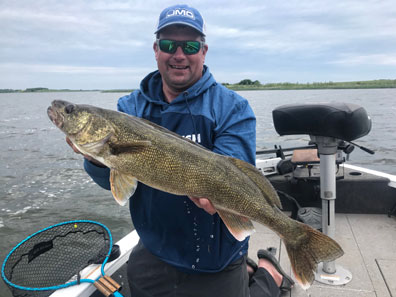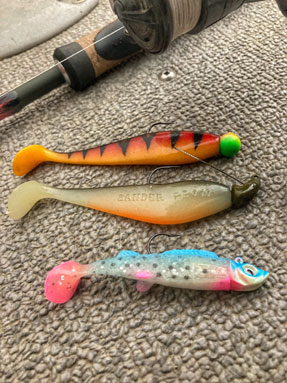Fall
Walleye By The Hour
By Jason Mitchell

September
walleye fishing can be about locations but also about the
process. Early fall seems more conductive for milk running
good
spots and simply covering water. Either by dunking into
several
spots through the day or big trolling passes. Grinding out
one
key location seems to burn us more because the fish are simply moving
too much. Time management is crucial any time of the year but
becomes magnified in the early fall when you simply must keep looking
for fish. Even after you catch a few fish, you often have to
keep
looking as we often find that we don’t find the magic spots that hold a
lot of fish rather a lot of spots that hold a few fish. This
is a
time of transition and your watch (time management) is as crucial of a
piece of equipment as your sonar or map chip. Typically, you
can
put together a good day if you can average a fish per hour.
Cover
enough water, hit enough spots so that you can average a fish an
hour. If you can average a fish per hour and then hit a
window or
spot where you cr
ack two to four fish in an hour at least once or
twice per day… the fish can add up to a good day. When fish
are
scattered all over which they often can be early in the fall, you
simply must keep moving and grooving.
Reading and
understanding locations is crucial in the fall and this knowledge will
help you catch more fish throughout the year…. Get as good as possible
at quickly finding the spot on the spot. They key ten-yard
piece
of structure on a bigger piece of structure. Some anglers
call
this the money spot. When you are combing water, hit as many
money spots as quickly as possible. Don’t worry about turning
over every rock or fishing an entire piece of structure. Hit
the
key locations on each spot as this is a much faster way of hitting as
many spots as possible. Will you sometimes miss fish with
this
aggressive approach? Sometimes but what I find is that if
there
are big fish or aggressive fish on a location, the big fish or
aggressive fish will often occupy the premium real estate. In
water deeper than twelve feet, we often won’t fish unless we see the
right fish on our electronics. We truthfully spend more time
driving around and looking versus fishing when running and gunning
deeper structure. Use ever tool at your disposal.
Traditional 2D sonar is still excellent for marking fish below the boat
on classic structure and I find that I can better determine the size of
the fish. Down view is excellent over deep mud or rocks where
it
is difficult to get separation. Side imaging is great for
finding
clutter over open water or showing fish over large flats that are made
up of small rock or sand. Fish on weeds however can be much
more
difficult if not impossible to mark with electronics unless the weeds
are sporadic and the fish are laying in the open.
What does a
spot on the spot look like? That is a question we hear a lot
and
usually that premium X on the map is some irregularity. Might
be
a finger and inside cup on a point where there is a change in contour
that coincides with a bottom change from sand to rock. Could
be a
patch of rock on a large sand flat that has scattered clumps of
weed. Might be a trough or channel edge that has some
irregular
feature. Look at the big picture and then dissect the overall
spot to find the high percentage spots. Usually, the bigger
spots
simply hold more fish so the spot on the spot that is part of a much
bigger spot is a high batting average location.
If there is one
standby in September however that I keep falling back on, that standby
would be shallow weed walleyes. If you can still find good
lush
stands of green weeds like cabbage or coontail, there are typically
walleye around. I like weeds because weed patterns seem to
stay
consistent through early fall when everything else in that ecosystem is
undergoing drastic change. Broad leaf pond weed or cabbage
varieties are top of the list but dollar weed, pencil reeds, wild rice,
coontail and dollar weed all hold walleye at times. I also
believe weeds hold in heat as well when the lake starts to cool in the
fall. There is just something surprisingly consistent about
weed
patterns during early fall that make shallow weed patterns somewhat
reliable.
Weeds however can be difficult to fish and you
just don’t roll into a weed location and figure out the intricacies of
a weed spot in five minutes. Weeds take time to figure out
come
late summer and fall. You might have to map out the outside
edge
of the weed line. You might have to experiment with angles
and
lures to fish the top of the weed bed. Typically, with weeds
and
walleyes, we aren’t going into the weeds after fish like you would if
you are bass fishing. We typically either fish the outside
edge
or the top edge. The open water on the edge is typically
where we
find walleye. Walleyes seem to cruise through these open
lanes
and move through these locations as they hunt. Walleyes seem
to
like gaps and lanes in weeds. Look for the gaps and lanes.

The
month of September is also a time when many of these weeds start to
break down and die but find standing green weeds with good water
circulation come late summer to early fall and there is a very high
probability of walleyes. What makes this pattern a favorite
is
that these fish don’t move as much and are just more consistent.
Manage
your time this fall. Have a good milk run of locations to
cycle
through and dabble with some green weeds when many fish are
transitioning. September walleye fishing can be inconsistent
and
sporadic. No doubt that the absolute best fall fishing is yet
to
come but there are some enjoyable opportunities to take advantage of as
we wait. The best strategy I have found is taking a big
picture
view of time management with a micro view of analyzing key locations on
a spot while falling back on weed fish when the pattern seems like
there is no pattern. We often must approach the time period
before the fall turnover with a completely different mindset but the
fish can add up through the day to create good fishing
opportunities.
Find
out more information at https://www.jasonmitchelloutdoors.com for
current videos, blogs and tips on walleye fishing. Watch
Jason
Mitchell Outdoors on Sunday mornings at 9:00 am on Fox Sports North and
Saturday mornings at 8:30 am on Fox Sports Midwest.